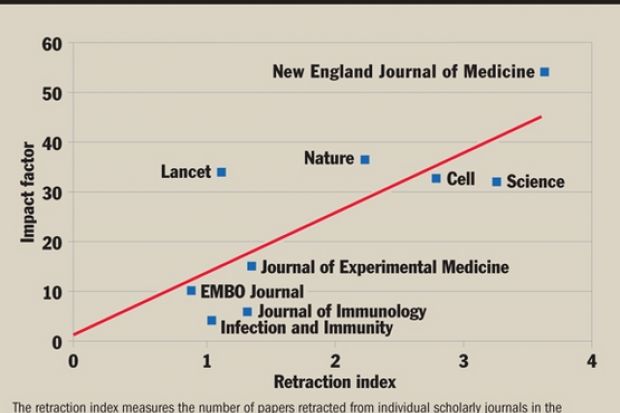Increasing pressure on scientists to publish in top journals may have contributed to a huge rise in retractions over the past decade, two academic editors have suggested.
Data from Thomson Reuters indicate that there was a 15-fold jump in the number of retraction notices between 2001 and 2010, from just 22 in 2001 to 339 in 2010. In the first six months of 2011 there were 210 retraction notices, suggesting that the numbers are continuing to climb.
Ferric Fang, editor-in-chief of Infection and Immunity, and Arturo Casadevall, editor-in-chief of mBio, have published a paper in the former journal that draws on data from the PubMed biomedical database to reveal a “surprisingly robust correlation” between the frequency of retractions in a particular journal and that journal’s impact factor.
“Although correlation does not imply causality, this preliminary investigation suggests that the probability that an article published in a higher (impact) journal will be retracted is higher,” the paper says.
The article, “Retracted Science and the Retraction Index”, suggests that the link stems in part from the greater scrutiny that papers in high-impact journals receive.
But the authors also speculate that the “disproportionate benefits” of publishing in a prestigious journal - such as improved job opportunities, grant success and peer recognition - may entice “desperate” authors “to take short cuts, withhold data from the review process, over-interpret results, manipulate images, and engage in behavior ranging from questionable practices to outright fraud”.
They argue that misconduct represents “the dark side of the hypercompetitive environment of contemporary science with its emphasis on funding, numbers of publications and impact factor. With such potent incentives for cheating, it is not surprising that some scientists succumb to temptation.”
The authors also contend that the stigma associated with retractions and the challenges of detecting misconduct mean that retractions probably represent “only the tip of the iceberg” of misconduct.
Professor Fang, who is also professor of laboratory medicine and microbiology at the University of Washington, wrote the paper in the wake of his journal’s retraction earlier this year of six papers by Japanese researcher Naoki Mori.
Professor Mori had been found guilty by his institution, the University of the Ryukyus in Japan, of manipulating images. He received a 10-year ban from publishing in all journals published by the American Society for Microbiology.
Professor Fang told Times Higher Education that it would be “worthwhile to take a hard look” at the contemporary scientific culture and the pressures that it places on scientists.
“In my view - and I know that many others agree - impact factor is widely misused as a surrogate measure of scientific quality and importance,” he said.
Thomson Reuters data confirm that high-impact journals tend to have the highest retraction rates.
However, the greatest number of retraction notices - 105 between 2006 and 2010 - were published by the crystallography journal Acta Crystallographica Section E, which has an impact factor of just 0.41.
All the retracted papers relate to a large-scale fraud, detected in 2010, by two researchers at Jinggangshan University in China, who were subsequently fired.
James Parry, acting head of the UK Research Integrity Office, said the rise in retractions reflected greater vigilance stemming from an increased awareness of research misconduct, but not necessarily more misconduct.
“While pressures on researchers can lead to poor practice in research or misconduct, the increase in retractions more likely reflects an increase in detection of relevant articles.”
Liz Wager, chair of the Committee on Publication Ethics, which advises editors on retractions, said the rise was partly accounted for by the advent of software that could detect plagiarism, as well as editors’ greater awareness of the possibility of image manipulation.
“But journals still don’t appear to react consistently - and some seem much more ready to retract than others,” she said.




